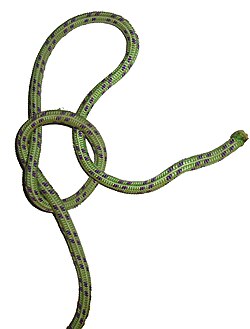(New page: {{Knot | name = Slip knot | image = Nœud de galère.jpg | use = A slip knot is one that will tighten under load, and which can be easily untied by pulling on the running end. This knot i...) |
|||
| Line 6: | Line 6: | ||
A slip knot can be tied by starting an overhand knot, but instead of passing the running end through the loop, pass a bight through instead. | A slip knot can be tied by starting an overhand knot, but instead of passing the running end through the loop, pass a bight through instead. | ||
| warning = If tied as shown in the illustration, the running end will pull through the loop under even the slightest load. If one reverses the standing end and running ends in the illustration, the knot is far more stable. As shown, the knot will hold a load on the running end, but not on the standing end. | | warning = If tied as shown in the illustration, the running end will pull through the loop under even the slightest load. If one reverses the standing end and running ends in the illustration, the knot is far more stable. As shown, the knot will hold a load on the running end, but not on the standing end. | ||
| + | }} | ||
Revision as of 02:21, 21 June 2007
| Slip knot |
|---|
|
Use: A slip knot is one that will tighten under load, and which can be easily untied by pulling on the running end. This knot is typically a component of more complicated knots, and is generally not used by itself.
How to tie:
|

